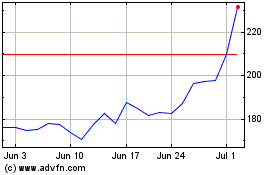By Gunjan Banerji and Michael Wursthorn
This article is being republished as part of our daily
reproduction of WSJ.com articles that also appeared in the U.S.
print edition of The Wall Street Journal (September 9, 2020).
Tesla Inc. was passed over for inclusion in the S&P 500
index, a move that put a halt to the parabolic run in the
electric-car maker's shares.
S&P Dow Jones Indices, which determines the makeup of the
index, said Friday afternoon that online marketplace Etsy Inc.,
technology firm Teradyne Inc. and pharmaceutical company Catalent
Inc. would be added in its quarterly rebalancing. Tesla -- whose
shares have catapulted to new highs, partly in anticipation of
joining the S&P 500 -- was noticeably absent.
Tesla shares dropped 21% Tuesday, their biggest one-day fall on
record. The stock still has nearly quadrupled this year, despite
declining 34% in September. Tesla's market value has ballooned to
nearly $308 billion, making it one of the biggest companies in the
U.S. by that metric.
The announcement is a particularly disappointing development for
bullish investors who had aggressively positioned themselves for
the company's addition to the gauge. After the company reported its
latest quarterly profits and plans to split its stock, many
investors bet big that its shares would continue to soar.
They may have gotten ahead of themselves. Tesla appeared to be
eligible for inclusion after its latest earnings report. To be
considered for the index, companies must report an accumulated
profit over four consecutive quarters, including the most
recent.
But a mathematical formula alone doesn't decide what is added or
deleted from the S&P 500. S&P's methodology for selecting
constituent stocks starts with a basic eligibility criteria,
including being based in the U.S., where shares trade on a major
American exchange. Beyond a few other rules, the S&P 500's
makeup is at the discretion of the index committee, which can
revise policies for selecting companies and make exceptions to the
process.
Shares of companies entering the index usually get a boost
around the time they join because more than $11 trillion in
investments track the S&P 500, leading to a flurry of potential
buying activity.
A spokesman for S&P Dow Jones Indices declined to comment on
the index committee's discussions about individual companies. A
representative from Tesla didn't immediately respond to a request
for comment.
Analysts pointed to a few factors potentially holding the
company back, such as its profitability metrics and sales of
regulatory credits to other auto makers.
Tesla made more than $1 billion from such regulatory credits
over the past four quarters, its financials show. That is more than
double its profits over the past four quarters.
"The quality of earnings could be a key issue with the
committee," Stephanie Hill, head of index-business and strategy at
Mellon, wrote in commentary ahead of S&P's announcement.
"Tesla's positive profitability has been driven by the sale of
regulatory credits to other auto manufacturers who need offsets in
order to reach their emissions standards."
Ms. Hill said volatility in Tesla's shares alongside the
sustainability of the company's returns also could play a role.
Tesla reported $428 million in revenue from the sale of emissions
credits in the most recent quarter, along with net income of $104
million.
The recent announcement doesn't mean Tesla won't join the
S&P 500 in the near term. A spokesman for S&P Dow Jones
Indices previously told The Wall Street Journal that the
eight-person committee can opt to include a new company at any time
-- even outside the quarterly rebalancing.
Still, the move highlights how unusual -- and controversial --
Tesla's ascent has been.
The company would be the biggest to ever join the index. As of
Friday, Tesla was worth more than nine times the combined value of
the three companies that were just inducted, FactSet data show.
On the popular trading app Robinhood alone, the number of users
who held shares of Tesla more than doubled to roughly 560,000 from
the end of April through early August, according to
Robintracks.net. Tesla shares were among the most widely purchased
stocks in July on TD Ameritrade's brokerage platform, a first in
four months as sentiment for the electric-car maker bubbled.
Charlie McElligott, a managing director at Nomura Securities
International, Inc., called the noninclusion a "fresh idiosyncratic
pain-point within the Nasdaq/momentum tech trade" in a note to
clients Tuesday.
Many investors had piled into short-dated, bullish options tied
to continued gains in Tesla stock continued gains, potentially
exacerbating its intense rally. Now, those options could be
magnifying its spiral lower.
"This matters from a 'knock-on' sentiment perspective with
regard to the 'trade from home' speculative frenzy.... creating
these hyper-convex 'crash up, crash down' moves," Mr. McElligott
wrote.
Tesla is one of the biggest components of the tech-heavy Nasdaq
Composite, which fell 4.1% on Tuesday shortly after the opening
bell.
--Tim Higgins contributed to this article.
Write to Gunjan Banerji at Gunjan.Banerji@wsj.com and Michael
Wursthorn at Michael.Wursthorn@wsj.com
(END) Dow Jones Newswires
September 09, 2020 02:47 ET (06:47 GMT)
Copyright (c) 2020 Dow Jones & Company, Inc.
Tesla (NASDAQ:TSLA)
Historical Stock Chart
From Mar 2024 to Apr 2024

Tesla (NASDAQ:TSLA)
Historical Stock Chart
From Apr 2023 to Apr 2024
